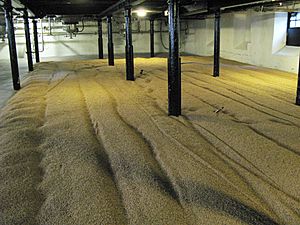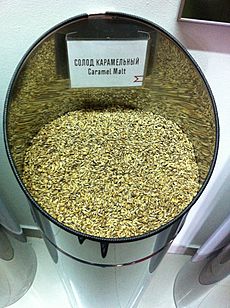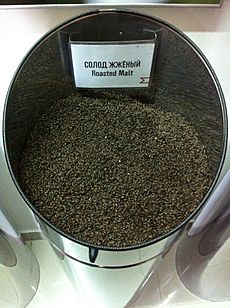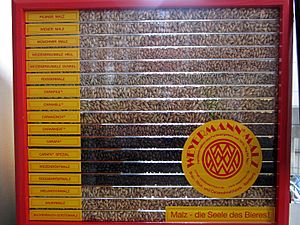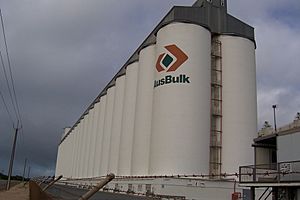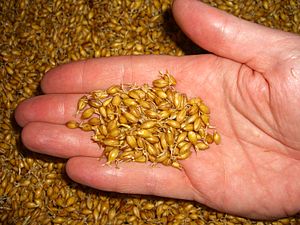Malting facts for kids
Malting is a special process that changes grain into something called malt. This malt is mostly used to make beer or whisky. It can also be used for malt vinegar or malt extract. Many different grains can be malted, but the most common ones are barley, sorghum, wheat, and rye.
There are different ways to make malt. In old-fashioned "floor malting," grains are spread out on a flat floor. Workers manually turn and rake the grains to help them grow and get air. Modern malt houses use machines. The grain grows on a special floor with slots, and air is blown through it. Big machines, like Saladin boxes, keep the grain loose. This makes the process faster and uses less energy.
Contents
Getting the Grain Ready
When grain arrives at a malt house from a farmer, it needs to be prepared. First, it's cleaned and dried if needed. This makes sure the grain stays in the best condition to become good malt. The grain is also tested to make sure it's healthy and ready for malting.
Some important checks include:
- How much water is in the grain.
- How much nitrogen it has.
- If there's any dirt or other stuff mixed in.
- If there's any mold growing on it.
- How well it can sprout or grow.
- How sensitive it is to water.
Drying the Grain
If barley arrives at the malt house with more than 13% moisture, it must be dried. This keeps it safe for storage without losing its ability to sprout. Warm air (up to 50 °C) is blown through the grain to remove the water. This can happen in special grain dryers or in a kiln. If the grain gets too hot or is dried too much, it can damage the barley seeds. Then, the grain won't sprout later. Once dry, barley can be stored safely for up to 18 months.
Cleaning the Grain
Cleaning the barley removes anything that isn't grain. This includes straw, dust, and thin kernels. Only the best grain is kept for malting. Magnets remove any metal pieces. This helps prevent sparks that could cause a dust explosion.
Rotating and shaking sieves remove bigger things like straw and smaller things like sand. A special system also sucks away dust and light husks. Machines called de-stoners separate small stones from the barley. The stones are heavier and move out of the machine differently. Sometimes, machines also remove broken kernels. This is important because only a whole kernel can sprout and make enzymes. After cleaning, the grain is weighed. Then, it moves to a silo for storage.
Storing the Grain
The barley must be stored carefully to keep it healthy and ready to sprout. Malt houses usually store grain in tall, vertical silos made of steel or concrete. These are easy to use. Sometimes, flat storage buildings are used for very large amounts of grain. The grain is kept safe from moisture and pests. A typical silo can hold between 5,000 and 20,000 tons of clean, dry barley.
During storage, the temperature inside the silo is checked regularly. If the temperature goes up, it can mean insects are active. Special equipment might be used to keep the grain below 18 °C to stop insects from growing. Silos often have a system to move grain from one silo to another. This helps break up any warm spots in the grain. A fumigation system can also be used to add a special gas (like phosphine) to kill pests.
The Wet Process
The wet process starts with soaking the grain in water. This helps it begin to sprout. It ends with drying the grain in a kiln. This removes moisture and makes the final malt stable.
A batch of malt is called a piece. A piece can be as big as 400 tons! Here's how a standard batch of malt is made:
Soaking the Grain (Steeping)
Steeping is the first step where the grain becomes active. Water is added to cover the grain. The grain's moisture goes from about 12% to 40-45%. In a modern malt house, the grain is soaked (wet stand) and then drained (air rest) a few times. This helps it reach the right moisture level. The first sign that the grain is sprouting is tiny roots appearing. These are called "chit." Seeing how many grains have chits shows how well the steeping is going.
When the grain is in water, air bubbles are blown through it regularly. This keeps the process full of oxygen, which helps the barley grow. Bubbling also mixes the grain well, loosens dirt, and balances water pressure.
After the wet stand, the water is drained. This starts the "air stand" or "air rest." Fans blow fresh air to give the grain oxygen and remove carbon dioxide. The air temperature is important; it should be between 10 and 15 °C. More air is needed during later air rests because the grain is more active.
When steeping is finished, the grain is moved to the germination area. This can be done while it's still wet or as moist grain during an air rest.
Sprouting the Grain (Germination)
The goal of germination is to make the barley grains grow. This helps them create special substances called malt enzymes. These enzymes change the inside of the barley kernel, breaking down its walls and protein. Growing grain creates a lot of heat. If not managed carefully, the malt can even burn!
The enzymes made during sprouting are very important. They break down the starch in the grain. This is needed later by brewers or distillers when they make beer or whisky.
The bed of grain is kept at a steady temperature, usually between 10 and 16 °C. This is done by blowing fresh, humid air through it. Machines called turners move through the grain bed to keep it loose. This allows enough air to flow through all the grains.
Drying in the Kiln (Kilning)
Kilning is the process of drying the grain and stopping it from sprouting. In the first part, called "free drying," the air is kept cool. This dries the grain without damaging the enzymes.
As the grain dries, the air temperature can be raised for the second stage, "forced drying." This dries the grain even more. The goal is for the malt to have about 5% moisture. During forced drying, the air coming from the grain bed becomes less humid. The maltster can then reuse some of this warm air.
In the last few hours of kilning, the air temperature is raised above 80 °C. This is called the "curing stage." This high heat helps reduce a substance that can make beer taste like sweetcorn. The high temperatures also give the malt its color through a process called the Maillard reaction.
Finally, the dried malt is cooled before it's removed from the kiln.
Removing Rootlets (Deculming)
The tiny roots that grow on the malt, called culms, are removed soon after the malt leaves the kiln. These removed culms are often sold as animal feed.
The cleaned malt is then stored in silos. It's often mixed with other similar batches of malt to create larger, consistent batches.
Final Malt Cleaning
Before the malt is sold, it gets one last cleaning. Sieves and air systems remove any dust, clumps, or small stones. Magnets are used again to remove any tiny metal pieces. This prevents them from damaging the machines that will grind the malt later.


